
Language Diversity
Linguistic Landscapes from four different countries
In this paper, the focus is on an analysis of five linguistic landscape signs found in Suriname, the Netherlands, the Czech Republic and Belgium. They give an indication of the diversity of languages used in these countries and of the impact the signs have on the local population.
Introduction
When we speak about linguistic landscaping, we speak about language use in the form of signs in public spaces all over the world. This can be done by professionals or amateurs and can therefore vary from commercial billboard signs to graffiti tags. These different signs almost always have a hidden meaning behind it.
Through linguistic landscaping, people communicate with each other in a broader context. These signs are mostly for a big audience. The signs are made for different reasons, from commercial branding to awareness creation. Most of the languages that people use in their public signs give an indication of which languages are relevant in that area. Those signs also give an indication of the identity of that city and of the languages of its inhabitants. For example, in a city in the Netherlands that attracts a lot of tourists, one will not only put up signs in Dutch but also in English or other languages. Mostly in English because English is an international language. This way, not only locals but also foreigners and expatriats can understand the signs.
Linguistic landscaping is therefore a useful method to understand the evolution of an urban space. Because I want to analyse those pictures on the angle of diversity of language use, my research question is as follows: What impact do multifunctional public linguistic signs have on the local population?
No Dyompo!
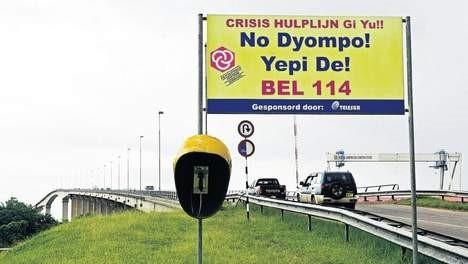 © Lindsay Lo-A-Njoe
© Lindsay Lo-A-NjoeFigure 1: No Dyompo! (Paramaribo, Suriname)

Figure 1: No Dyompo! (Paramaribo, Suriname)
I will start with a photograph of a billboard sign that was taken in Suriname at the Jules Wijdenbosch Bridge (In Dutch: Jules Wijdenboschbrug). This bridge connects Paramaribo and Meerzorg and was built in May 2000. Ever since it was built, a lot of people committed suicide by jumping off the bridge. Mostly with success and just a handfull of people have survived the jump. A few years later, the government opened a helpline for depressed people who consider suicide as an option.
This billboard sign had therefore been put up at the foot of the Jules Wijdenbosch Bridge. The languages written on this sign are in Dutch and Sranan Tongo. Dutch is the official language in Suriname and Sranan Tongo is the most commonly used linguafranca in Suriname. Sranan Tongo is also an English-based creole language. On the billboard is written: “CRISIS HULPLIJN GI YU!!/ No Dyompo!/ Yepi De!/ BEL 114/ Gesponsord door: Telesur”. This translates: CRISIS HELPLINE FOR YOU!!/ Do not jump!/ There is help!/ Call 114/ Sponsored by Telesur.
Since the languages used in this sign are Dutch and Sranan Tongo, we can mention crossing or codeswitching. Crossing means that the linguistic styles of one or more ethnic groups associate with each other (Van Herk, 2012). Also noticeable are the colors that have been used on this sign: red, white, blue and yellow. Telesur is one of the telephone operating companies in Suriname and it uses the theme colors yellow, white and blue. At the bottom of the sign it is written “sponsored by Telesur”. That is the reason why they used the colors to paint the billboard sign (Telesur, 2016). Calling the number 114 is free and made possible by Telesur itself. In a way, this is also a way for Telesur to advertise themselves to the community. They try to say “we are here in desperate times; we like to help the people who want to commit suicide”.
In front of the billboard there is also a payphone which people can use to call the helpline in case they do not have a mobile phone in reach. The payphone also has the color yellow. That means that the payphone had been placed by Telesur itself. On the billboard at the left there is a sign in red and three white circles referring to the text “Psychiatrisch centrum Suriname”, which translates Psychiatric Center Suriname. That means that Telesur works in association with the Psychiatric Center Suriname to help people with suicidal issues. The people behind the helpline therefore are most probably connected to or working at the psychiatric center. With their expertise, they help the people with suicidal issues by talking them down and helping them with their problems.
Big John
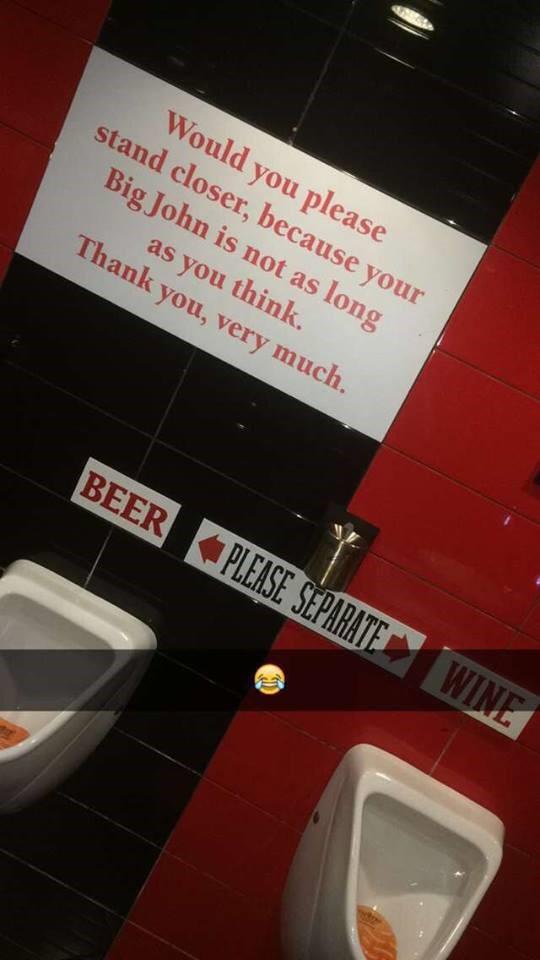
Figure 2: Big John (Prague, the Czech Republic)
The second picture was taken at a restroom in a restaurant in Prague. My half-sister posted this on social media because it was hilarious in some way. The sign was obviously placed in the men’s restroom, and it is directed to the men who visit it. Some do not pee directly into the pot, but sometimes besides it. Therefore, the sign tells the men to stand closer to the pot so they do not pee outside the pot itself. Also noteworthy is that they separate two pots: one for those who drank beer and one for wine.
The text written is as follows: “Can you please stand closer, because your Big John is not as long as you think”. From the toilet pots you can see that the sign has been sorted out by gender. When we speak of gender we speak of a socially constructed image that a person has of oneself (Van Herk, 2012). When reading this sentence, the first thing that strikes are the words “Big John”. Noticeable is that they do not use the word “penis” in this context but try to put a little bit of humor into the sign. Instead of using the word “penis” they use “Big John”. Big John is often used to refer to a large penis. Even if someone would not know what “Big John” means they could understand it in this context.
The sentence is therefore a contradiction of itself. The sign says that “…it is not as long as you think”. This is funny because the sign says that their Big John is small. Therefore, the men who call their penis a Big John, often have a big ego and foster their own image about themselves; they think they have a large penis. However, the sign refers to their penis as small in this context. At the end they politely thank the costumer for following the sign ("Thank you, very much"). Thanking people after, instead of insulting them, is a soft way of getting off the hook and not allowing the customer to take it personally.
At the bottom finally, the sign also separates two kinds of pots, one for beer drinkers and one for wine drinkers. The suggestion to urinate in different pots related to what you drank is just another funny addition to this sign. It all adds to the sign’s intention. Getting the user’s attention for the request not to urinate outside the pot.
Wegdek in slechte staat
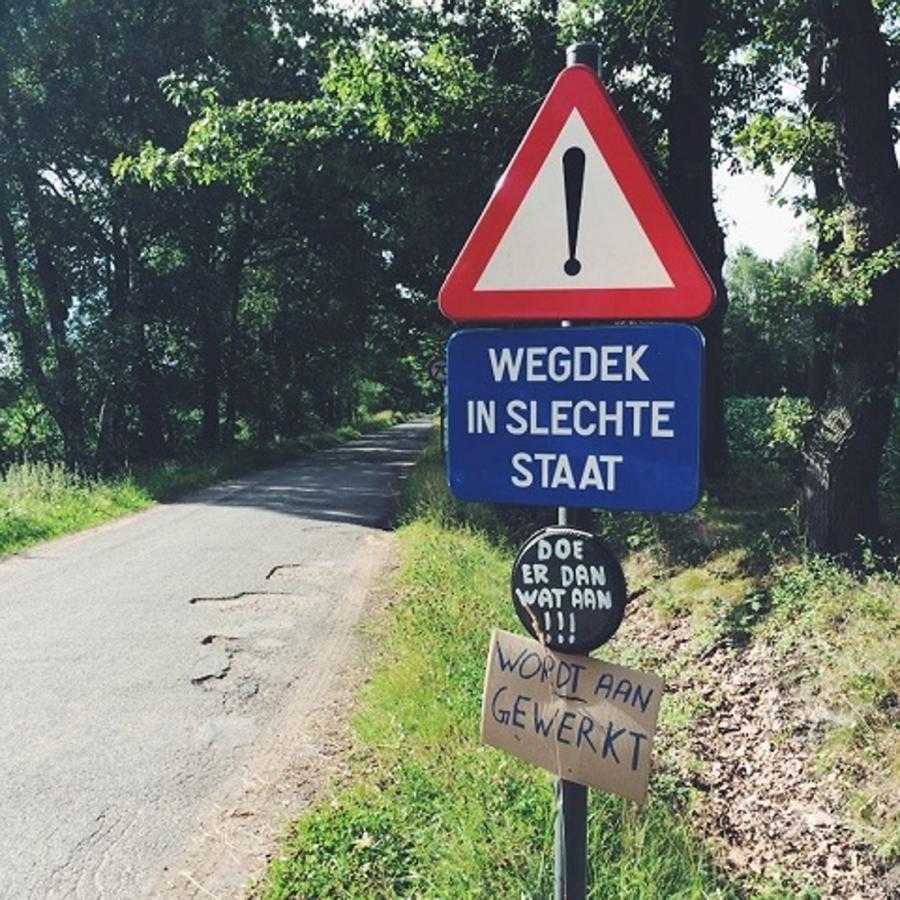
Figure 3: Pavement in poor condition (Zonhoven, Belgium)
The third picture was taken at De Borgersheidestraat in Zonhoven, Belgium. The triangular red and white sign with the exclamation mark and the blue plate are official traffic signs that the government uses on the streets. The language used in this picture is mainly Dutch. The sign on the blue plate says “pavement in poor condition”. Underneath the official sign, the locals have put up another sign that says “Then do something about it!!!”. The third sign that looks like it has been written on cardboard is a response to the local’s remark on the sign. That sign translates “Working on it”. The third sign could have been put up by locals themselves, who think this is hilarious or actually by public workers who are fixing the street. That sign implicitly asks the angry locals to be patient because the road will be fixed soon.
It is clear that the main sign had been placed by the government. We can therefore speak of a top-down sign (Edelman, 2010). Beneath that sign, another sign has been placed which translates: “Then do something about it!!!”. Because of the three exclamation marks, we can clearly see that we are dealing here with some angry locals who are tired of the bad road and want the government to fix it. The sign has been placed by locals and is directed to the government. We can therefore speak of a bottom-top sign (Edelman, 2010). The reason the locals get angry is because of the taxes they most probably pay whereas the government does not invest in the infrastructures.
The third sign that has been written on a piece of cardboard translates: “Working on it”. This sign could have been placed by other locals to give a response to the angry ones. Another alternative is that public workers placed that sign because they are actually working on the street. The last sign looks calm and without exclamation marks. It intends to calm down the impatient locals instead of getting angry. The government is working on reconstructing the street and that may take a while. The locals should therefore keep calm. The moral of the story is that people can communicate through public signs. The remark of the angry local can also be seen as a form of protest. Stating that the government does not do anything about the bad road. The signs in public spaces can therefore be powerful and draw attention to the matter (Blommaert & Maly, 2014).
VAHS
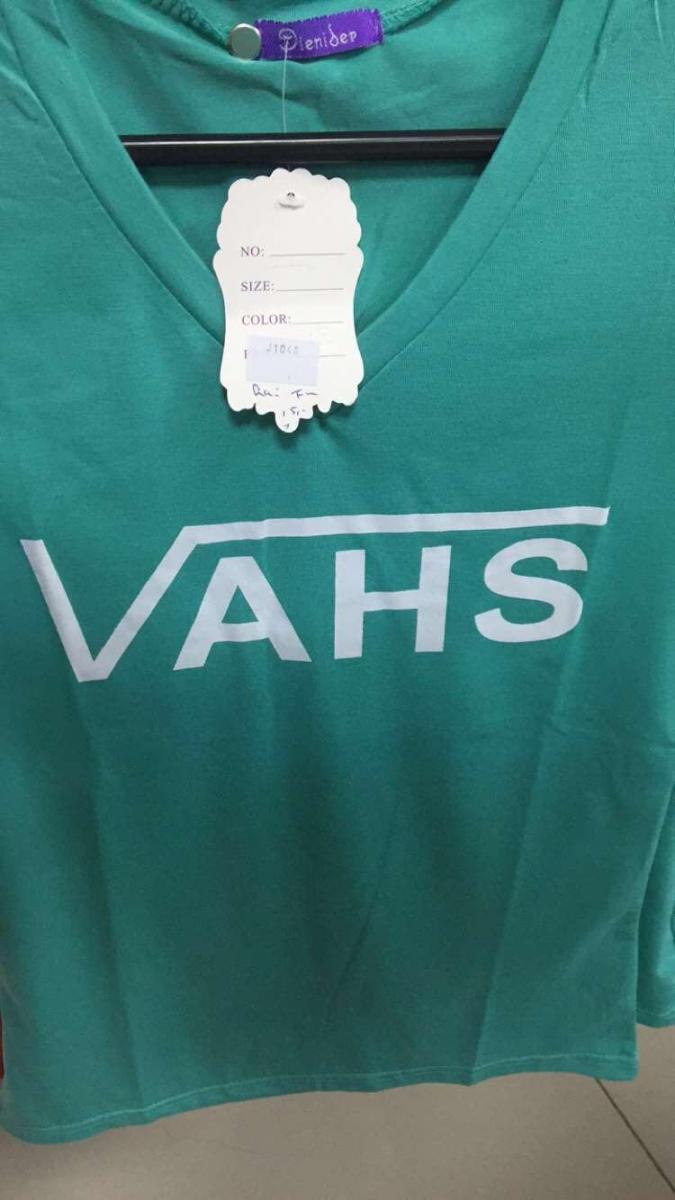 © Lindsay Lo-A-Njoe
© Lindsay Lo-A-NjoeFigure 4: VAHS (Paramaribo, Suriname)

Figure 4: VAHS (Paramaribo, Suriname)
Sign four is a T-shirt that has “VAHS” written on it. As I mentioned above, this picture was taken in Suriname in a Chinese clothing shop. If someone would quickly take a look at this picture they would probably not see any flaws in it. Instead of “VAHS”, there should have been written “VANS” on that T-shirt. VANS is a well-known international brand, mostly known for its shoes “VANS off the wall”.
The VANS brand has the same way of writing as is used on the T-shirt. Since the 19th Century, Chinese immigrants have been migrating to Suriname in search for a better life. These Chinese immigrants already started shops in Suriname over a decade ago and are still located all over the country. The larger half of the Chinese community in Suriname makes a living out of entrepreneurship (Bourcier, 2015). It is also well-known that Chinese clothing shops sell a lot of fake products, much like this T-shirt (De Jong, 2010). As entrepreneurs, they want to sell a lot of their own (fake) products to limit their expenses. Therefore, they make their own products based on other well-known bestselling brands. Copying someone else’s brand and ideas without the owner’s permission is seen as a crime. To avoid being dragged to court, they slightly diverge from the original brand itself to make it seem as their own creation. On the label of the shirt you can also see that nothing of the detailed color or size had been filled in. Only at the bottom of the label can you see the price of the T-shirt (15 Surinamese Dollars). The label also gives an indication of a fake product as no detail of the shirt has been written on it.
M-Tag
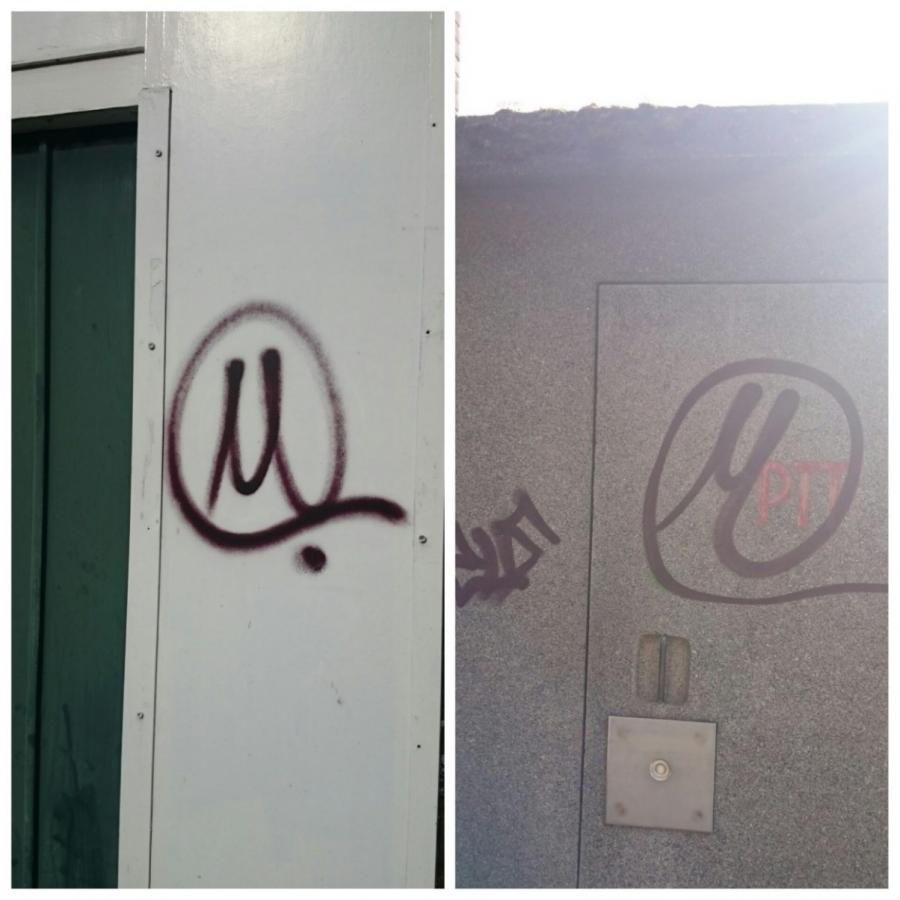 © Lindsay Lo-A-Njoe
© Lindsay Lo-A-NjoeFigure 5: M-Tag (Tilburg, the Netherlands)

Figure 5: M-Tag (Tilburg, the Netherlands)
The last picture I am going to analyse is a graffiti sign that occurs a lot in Tilburg, Netherlands. Above you can see two pictures of the M-tag that had been captured at different locations in the city. This tag has mostly been sprayed on walls and electricity boxes. A graffiti tag is the most common and simplest way to put up your signature with spray paint. The tag is usually a name or just a letter. This M-tag has been sprayed by different people all over Tilburg. Even though this sign is quite small, it can have deeper underlying motives behind it. When people just look at the sign, all they see is a doodle or an initial. The M-tag has a background story of a young boy named Marlon Jacobs who committed suicide in 2008.
The M-Tag is a graffiti piece that consists of only one letter. When you look at the tag you can never immediately understand the meaning behind it. Only after doing some research, you will learn what deeper underlying structures this one simple tag has. The story behind this M-Tag is about a young Tilburgian guy named Marlon Jacobs who committed suicide in 2008. The M-Tag was created as a gift that he once gave his mother. After his death, his friends decided to place his tag all over the city. Even eight years after his death, his tag still lives on; people still place the tag all over Tilburg to keep his memory alive (Mensenling, 2008).
This is a great example that shows how only one letter or scribble can say so many things at once. People place it in public locations which can have greater meaning for the locals (Blommaert & Maly, 2014). Just one small symbol with a story behind it. One sign, the M-tag has different meanings and comes in different forms: there are a lot of variations of the M-tag that have been sprayed in Tilburg. This is because of the different authors who decide to put up the tag to commemorate Marlon Jacobs. The newer M-tags slightly differ from the original one due to the different people who spray the tag around Tilburg.
Comparison and conclusion
The first sign that I analyzed is clearly a combination of promoting a brand and a portrayal of concern for people’s lives. The telecom company Telesur takes advantage of the situation to get their brand noticed by working with the Psychiatric Center of Suriname. They cooperate in order to help people with suicidal issues and also to promote themselves. Because of the Sranan Tongo they use, it is clear that the sign is meant for locals. The picture of the toilet is a combination of a request and humor. This sign is directed to men who visit the restaurant because the sign was placed in the men’s bathroom. From this picture we can conclude that the restaurant owners request the male guests to pee in the pot and not outside of it and therefore to stand closer to the pot. The humor behind this sentence is that they use the words “Big John” in a certain context. It comes down to the meaning that men have a great image of themselves accompanied by a huge ego. That underlying connotation of course is revealed in a humorous way. In the third picture, the official traffic sign is meant for drivers who pass the road. It serves to warn them that the road is in bad condition heading in that direction. Locals who do not see any changes of asphalting the road can eventually get angry and irritated because of the taxes they pay and the negligence of the government. This sign can be seen as a bottom-top conversation. The sign on the cardboard therefore intends to calm down the locals by writing “Working on it”. The forth picture is a fake T-shirt sold by a Chinese clothing shop in Suriname. This mistake is made intentionally in order to avoid trouble in court. People who know the original brand will see the flaw on the fake T-shirt and react differently than someone who has no clue of the original brand. The last picture is a commemoration graffiti tag that people spray paint all over Tilburg. This M-Tag was created by a graffiti artist Marlon Jacobs who committed suicide in 2008. After his death, the tag was sprayed all over Tilburg. Due to the different authors, there are also slight differences and variants of the tag as compared to the original M-Tag. Either way, it still has the same meaning behind it.
All of these pictures have a great impact on the locals for which they are meant. The pictures are from different countries but you can see that signs do influence people on different levels. The first picture can make people change their minds and help them through tough times. The second picture can be seen as humor and therefore make people laugh. The third picture is an official traffic sign which cannot only be accepted by locals but can also be rejected and even contested. Locals can get angry if bad situations are neglected by the government. They use the sign to send a message to the government. The picture of the fake T-shirt can also affect the locals who shop in these Chinese clothing stores. Locals will become suspicious of the fake brand and most of them will reject to buy such a T-shirt knowing it is a fake. In Suriname they use the term “originees” which is a combination of the Dutch words “origineel” and “Chinees”. This word is mostly used in a negative context to refer to fake products. Locals would want to buy nice-quality products instead of fake ones. The last picture is about the M-tag graffiti which has a sentimental story behind it. Because of this background story, it has affected a lot of locals who decided to spray the M-tag in all the neighborhoods of Tilburg to commemorate Marlon Jacob.
Public signs can have great impact on local inhabitants whether those signs are placed on billboards or placed as graffiti tags. These signs can have different impacts on people depending on their emotional level. When people can relate to certain signs they can understand these better and feel the context. In certain situations, signs can be helpful and make a great difference in someone’s life (picture 1). Signs can also be seen as humoristic or offensive, like the bathroom sign. People can use official signs also as a way to send messages about things they want to see change. Because of the fake products that entrepreneurs produce daily, a lot of people are more alert when they buy products in Chinese shops. The graffiti M-Tag is a way to commemorate the Tilburgian guy, named Marlon Jacobs, who committed suicide. Even after several years, its meaning has not been lost and has still lived on due to the different authors who decide to spray the tag in Tilburg. Therefore, public signs mainly have an emotional impact on locals if those locals can relate to the signs.
References
Ager, S. (2016). Sranan. Retrieved June 3, 2016, from Omniglot, the online encyclopedia of writing systems & languages.
Blommaert, J., & Maly, I. (2014, June). Ethnographic linguistic landscape analysis. Retrieved June 6, 2016.
Bourcier, N. (2015, June 23). China finds an eager South American stablemate in Suriname. Retrieved June 1, 2016, from The Guardian.
De Jong, S. (2010). Namaakspullen. Retrieved June 5, 2016, from Volksrepubliek China.
Edelman, L. (2010). Linguistic Landscapes in the Netherlands; A study of Multilingualism in Amsterdam and Friesland. Retrieved June 3, 2016, from LOT publications.
Mensenling. (2008, December). Overlijdensbericht Marlon Jacobs. Retrieved June 1, 2016, from Mensenling.
Psychiatrisch centrum Suriname. (2016). Retrieved June 6, 2016, from PCS.
Psychiatrisch centrum Suriname. (2016). Diensten. Retrieved June 7, 2016, from PCS.
Telesur. (2016). Over Telesur. Retrieved June 7, 2016, from Telesur Keeping us in touch.
Van Herk, G. (2012). What is sociolinguistics? United Kingdom: Wiley-Blackwell.
Wikipedia. (2016). Graffiti. Retrieved June 8, 2016, from Wikipedia, The Free Encyclopedia.